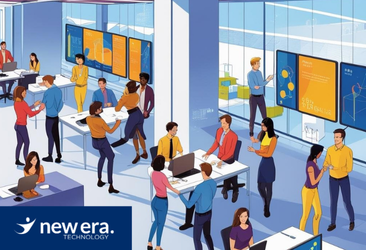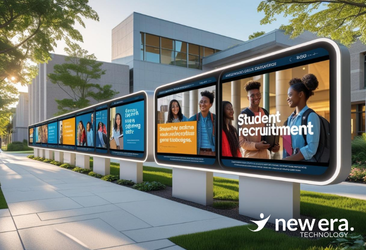”When it comes to creating seamless collaboration spaces for modern work, choosing the right technology is crucial. There are several factors to consider when selecting the appropriate technology for your organisation’s needs.
In this blog post, we will explore the importance of selecting the right technology for video collaboration in modern workspaces and provide tips for making the best choices.
Understand the needs of your workspace
Before you invest in any new technology for video collaboration, it is essential to start by understanding the specific needs of your workspace. Every workspace has unique requirements and priorities, so it’s important to assess what features and functionalities are necessary for seamless video collaboration. Underestimating the importance of this step could result in costly mistakes for your modern workspace that do not meet the needs of your users and therefore ultimately fail.
Consider factors such as the size of your workspace, the number of employees who will be using the video collaboration tools, and the nature of the work that will be done. Are there specific tasks that require advanced video capabilities, such as screen sharing or virtual whiteboarding? Understanding these needs will help you narrow down your options and choose the technology that best aligns with your workspace requirements.
‘New Era work in a consultative way to help ascertain these needs, including outcome based workshops with stakeholders and end users to determine the MoSCoW prioritisations and requirements. In understanding the physical space itself and limitations which may impede certain technologies the design stage is key and documenting this with detailed drawings, schematics and functional specifications would be expected and even 3D renders can help bring solutions to life. Training would be delivered with a support wrap in place for long term success’ – Chris Young, Senior Strategic Account Manager
Understand your environment is unique
The physical space you are creating your video collaboration environment in can play a big part in the technology and equipment that will work for your orgnanisation. Things to consider:
- Noise suppression and voice isolation – if the room is acoustically challenging (flutter echoes, close to noisy spaces . . ) then consider how vendor technologies delivering audio enhancements can help overcome such issues
- Ceiling speakers – to minimise sound transfer to other areas, ceiling speakers can give a more uniform distribution of sound and avoid participants at the front of the table suffering excess volume levels
- Cable routing – what restrictions does the space present in routing cables. Do solid floors prevent new cable routes. Is wireless connectivity or standard CATx cabling a better option?
- Ceiling or table microphones – how will the space work? Will the table(s) be moved to support different room configuration and will ceiling microphones help support this flexibility?
‘Once the outcomes are defined, technology selection can then take place, New Era is agnostic and will work with all certified vendors to ensure quality is assured and solutions are as future proofed as they can be in an ever changing landscape’ – Chris Young, Senior Strategic Account Manager
Engage your end-users
With hybrid here to stay and things like BYOD becoming the norm you really need to gauge how your end-users want to use the spaces you provide.
Creating immersive spaces with all the latest tech is one thing, but if the VC ecosystem you create does not service the needs and wants of your employees it could fail. Ensure you run a detailed analysis with your users/stakeholders at the beginning of the project as this will form a major part of the objectives you set. Once you know what you need to achieve you can find the technology that will best support this.
Consider how your users will join meetings and what type of meetings they want/need to hold. Will they require interactive collaboration with sharing of content and how do you ensure you offer this equity of experience for both in-person and remote participants? Ensure you fully understand the user needs and work this in to your key project objectives.
Furthermore, ease of use and accessibility are crucial factors to consider. The technology should be user-friendly, with a simple interface that allows participants to join meetings and navigate the features effortlessly. Compatibility with different devices, such as laptops, tablets, and smartphones, is also important to accommodate the diverse needs and preferences of employees.
Explore different Video Collaboration technologies
Once you have a clear understanding of your workspace needs, it’s time to explore the different video collaboration technologies available in the market. There are various options to choose from, including video conferencing software, hardware systems, and cloud-based solutions.
It is essential to assess the video conferencing capabilities of a wide range of technologies and vendors. We would recommend working with a ‘vendor neutral’ service provider who will make recommendations that meet your objectives. It is important to remember that working with one vendor will limit your technology choices. Research and compare the features and functionalities of each technology. Consider factors such as ease of use, scalability, audio and video quality, and compatibility with different devices and operating systems. It’s also important to evaluate the user interface and user experience of the technology to ensure that it is intuitive and user-friendly for everyone in your workspace.
‘New Era has experience in continual cycle refreshes and transitions from different technologies over the years including Immersive Telepresence, Standards based VC solutions with interop and white glove services, to native ecosystem solutions across Microsoft Lync, Skype for Business to Teams and Zoom and anything in between.’ – Chris Young, Senior Strategic Account Manager
Look for solutions that offer high-definition video and audio quality to ensure clear and uninterrupted communication. Additionally, consider features like screen sharing, virtual backgrounds, and chat functionality, as these can enhance collaboration and engagement during meetings.
Consider integration and compatibility
When selecting video collaboration technology for modern workspaces, it’s crucial to consider integration and compatibility with your existing systems and tools. Evaluate whether the technology can seamlessly integrate with the existing tools used within your organisation, such as project management platforms, document sharing systems, and instant messaging applications. This integration enables a streamlined workflow and enhances productivity.
Does the solution need integration with existing collaboration or other applications? What space management solution is in place and will the collaboration tech support that for seamless scheduling and room utilisation analytics?
Outside of the room is just as important as inside the room, in fact, the journey begins before you even walk through the doors of your offices. Ensure the workflow meets the needs of your users as if it were an experience or attraction visit. Booking space in a seamless way, arriving at your destination and entering the building with knowledge of exactly what you need to do, where you need to be and when you need to be there.
Compatibility with different devices and operating systems is also essential, especially if you have employees using a variety of devices. Ensure that the technology supports multiple platforms, including desktop computers, laptops, smartphones, and tablets. The ability to collaborate across different devices will enhance productivity and enable seamless communication within your workspace.
Assess security and data privacy measures
Security and data privacy are paramount when it comes to video collaboration in modern workspaces. Before making any technology choices, thoroughly assess the security measures and data privacy policies of the video collaboration solutions under consideration.
Look for technologies that offer end-to-end encryption to protect sensitive information shared during video conferences. Check if the technology complies with industry standards and regulations, such as GDPR or HIPAA, depending on the nature of your workspace. Additionally, consider whether the technology offers features like password protection, user authentication, and secure data storage to ensure that your workspace’s data remains safe and confidential.
‘In most cases, standard cloud services such as Teams and Zoom will meet the requirements – but is a more secure private cloud or on-premise solution required to provide required levels of security?’ – Andy Porter, Strategic Account Manager
Evaluate cost and return on investment
Cost is an important factor to consider when choosing technology for video collaboration. Evaluate the upfront costs, ongoing maintenance expenses, and any additional fees associated with the technology.
However, it’s equally important to consider the return on investment (ROI) that the technology can provide. Assess how the technology will impact productivity, efficiency, and collaboration within your workspace. Will it reduce travel costs by enabling virtual meetings? Will it improve communication and decision-making processes? Understanding the potential benefits and ROI will help you make an informed decision and choose the technology that offers the best value for your workspace.
Ensure your technology investment is futureproof and scalable
Lastly, it’s essential to consider the scalability and future-proofing of the chosen technology. As the organisation grows and evolves, the technology should be able to support increased usage and accommodate emerging collaboration trends and requirements. Scalability ensures that the investment in multipurpose video spaces remains relevant and effective in the long run.
‘Taking a modular approach will allow devices to be upgraded whilst retaining the rest of the tech. Perhaps camera AI and resolution improvements justifies a device change . . . connecting to the rest of the solution already in place. Using devices certified for the chosen meeting service will ensure updates long into the future.’ – Andy Porter, Strategic Account Manager
Summary
By carefully evaluating and selecting the right technology for seamless collaboration, organisations can maximise the benefits of their multipurpose video spaces and create an environment that fosters efficient and productive teamwork in the modern workspace.
Contact us to find out how we can support you further on your video collaboration journey

 Australia
Australia Canada
Canada LATAM
LATAM New Zealand
New Zealand UAE
UAE United States
United States








